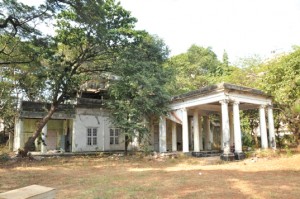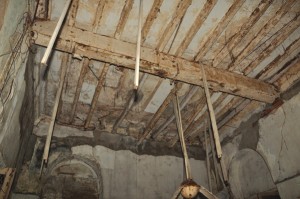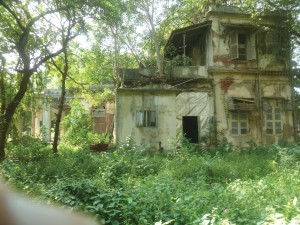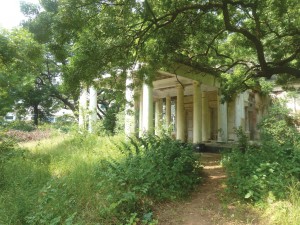Registered with the Registrar of Newspapers for India under R.N.I 53640/91
Vol. XXVI No. 19, January 16-31, 2017
It’s time SBI remembered Dr. Anderson
by Geeta Padmanabhan
It is Vakula Varadarajan who alerts me to the bungalow that James Anderson built. We walk down Anderson Road in Nungambakkam, not sure where it was or what it looked like. Then, there it was, on the side opposite the British Deputy High Commissioner’s residence, its white front columns highlighted by the tangle of trees around.
As we trudge through the wild undergrowth, round the centuries-old woodapple, tamarind trees, past mounds of rubble and earth – we piece together Anderson’s legacy. James Anderson (1739-1809) was a scot of many parts, Varadarajan begins.
 The sorry state of this once-proud heritage home is seen in the pictures below.
The sorry state of this once-proud heritage home is seen in the pictures below.
A qualified surgeon, he -arrives in Madras 1761, became assistant surgeon with the -English East India Company at Fort St. George (1765), Surgeon (1786) and then Physician-General. A combination of curiosity, academic excellence and public-mindedness got him interested in “adventures” outside his medical training.
No doubt excited by the tropical lushness around, Anderson plunged into serious botanical research in 1771. While attending to his patients, talking of vaccination and promoting industries that would benefit EEIC, he fell passionately in love with cochineal insects, used in the extraction of the crimson dye. He believed that the quality/colour of the dye was influenced by the plants they ate. So he caught the cochineal insects growing on the sandy beaches of Madras and bred them on cacti, according to letters he wrote to Joseph Banks, Company advisor.
The Company saw how this would make dye cheap and allowed Anderson to start a nopalry (a nopal/cactus nursery) in Madras. By 1791, a 2-acre plot in Saidapet was bristling with Nopal de Castile, their minuscule spines visible only under a magnifying glass. Slowly, -however, his cactus garden got neglected. The cyclone of -December 9, 1807 severely damaged the nopalry and the neighbouring botanical gardens. The plants that managed to survive were shipped to Lal Bagh, Bangalore. The run-down nopalry was declared a failure, a part of it was joined to the Government Botanical Gardens (later Lusington Gardens), the rest given up for growing rubber trees. Eventually, it was parcelled out and sold for “development”.
Between 1778 and 1792, in a 110-acre area on the banks of Cooum, Anderson grew a garden of rare trees. Following Tippu Sultan’s efforts at sericulture in Mysore, Anderson imported silkworms from Bengal in December 1790. He planted mulberry (Morus, Moraceae), and enthusiastically reared silkworms for six years. He designed a reeling machine, invited reeler Mahomet Arid Ulna from Bengal and two months after receiving the silkworms, Anderson was sending silk reeled from their cocoons to London! This area, which included his house, became Anderson Gardens and survived till 1828.

Deeply interested in the flora of Coromandal coast, Anderson did research in illuppai, mahua, neem, and teak trees, tried to grow sugarcane, coffee, American cotton and apple. He recorded the results of his researches in the books Varnish and Tallow-Trees (1791), and Culture of Bastard Cedar Trees on the Coast of Coromandel (1794). In an eloquent letter to Robert Brooks, Governor of St. Helena, he says:
“What benefits would result to society, if men of letters would in general turn their attention towards useful pursuits!”
Quite some work, but Anderson should be remembered for the two structured botanical gardens he created in 18th Century Madras: the cactus garden in Marmelon (Mambalam–Saida-pet) and Anderson Gardens (Nungambakkam). Yes, Anderson wanted to better Britain’s economy by exporting India’s natural produce and know-how, but don’t question his spirited efforts to understand tropical plants and their usefulness to humanity. Andersonia (Melia-ceae) celebrates his contributions to Indian botany.

In the middle of his frenetic botanical activities, Anderson managed to build a grand mansion for himself. Describing it, archaeologist Dr. Satyamurthy says, “He constructed a marvellous building in Indo-British style in colonial model with ground and first floor. The inner ceilings are high and laid with Madras terrace. There are tiles that look ancient. The mansion accommodated his office and residence.”
Anderson died on August 6, 1809. Once he was gone, his beloved garden and residence were acquired by Thomas Bycrafts. Subsequently it went into the hands of the State Bank of India, and the Regional Headquarters functioned from here till the 1980s. “Then, lack of maintenance left it defunct, crumbling,” said Dr. Satyamurthy. Noting its historic value, he adds, “the Heritage Committee of the CMDA notified it as Category IA (as per the Justice Padmana-bhan Committee’s classification), informed the SBI officials about it and asked them to preserve it without any change.” On the request of SBI’s Additional General Manager, Chennai, the REACH team inspected the building and submitted a preliminary report with a proposal to cut the vegetation and implement precautionary measures to prevent its fall. It would cost the bank not more than 2 lakh.

“REACH had drawn an emergency rescue operation but there was no response from the bank authorities,” says Dr. Satya-murthy. “SBI seems to be waiting for the building to fall. They want to pull it down and construct a commercial building. If this is the attitude of a government bank, how is CMDA going to preserve heritage is the question now.”


My maternal grandfather’s address was Anderson’s Gardens, Madras when he was Deputy Superintendant of Police for the Madras Presidency in the 1930s to 1946. His name was James Beckett. I don’t know if he was well regarded by Indians but I would be interested if you have any photos, records or information from that era.
Thanks for a fascinating article!
Very interesting article i was reading about mulberry in madras resulted in this article
Thanks for the interesting article
Arun
Anderson House used to be the residence of the General Manager (then known as the Deputy Secretary & Treasurer) of the Madras Local Head Office of the State Bank of India. During 1962-1965 my father Shri
R.K. Talwar (who went on to become the Chairman of SBI in 1968) held this position. And this house was where I lived for 3 yrs with my parents as an 8-10 year old boy. I have my fondest memories of this house.